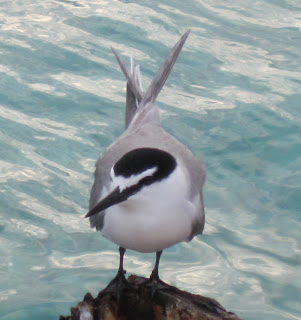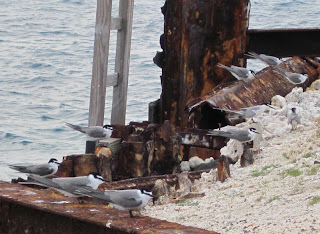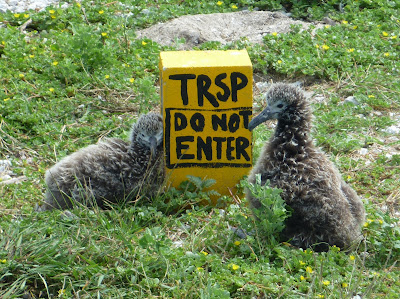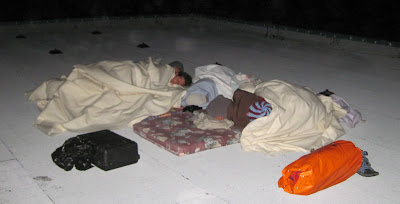 |
| Pākalakala (gray-backed Tern) |
The pākalakala -- gray-backed terns -- are back, and starting to find mates! Pākalakala roam across the Pacific, breeding on the northwest Hawaiian islands and some small islands near the main Hawaiian islands, like Ka’ula (near Ni’ihau) and Mokumanu (O’ahu), as well as a few other Pacific Islands. They have become locally extinct on many islands due to rats and/or feather or egg hunting. The largest extant breeding population is in the northwestern Hawaiian islands, although we don’t really have a good grasp of the current population status – Populations studies for this species were mostly conducted in the 1960’s and 1970’s.
Pākalakala look a lot like sooty terns, except sooties have black backs. Gray-backed terns are also much more flighty, and less aggressive than sooty terns – maybe that's why there’s hundreds of thousands of sooty terns, and only a few dozen gray-backed terns on Tern Island. Pākalakala live into their 20s, and maybe longer.
 |
| Gray-backed terns returned to Tern Island! Yeah! Pākalakala may be my favorite bird here, because they don't bite, they don't peck -- they're just kind of more subtle altogether. The highest numbers of these birds are on Lisianski, Nihoa and Laysan Islands in the Northwest (at least as of the 1980's). As far as I know, we're the only ones regularly monitoring this population, however. |
There is very little known about pākalakala behavior beyond what little we see during their breeding season. They are very skittish, and will fly off as soon as a person approaches the area, leaving their egg or chick alone (but they do come back as soon as you leave, or if you sit down in the same place, motionless, for a while). They have only one egg at a time, but we really don’t know if they re-lay or not, if their first egg fails. It's very important that we don’t disturb them too much, as the eggs and chicks are very likely to be eaten by great frigatebirds (‘iwa) when their parents are not there. ….This is also why pākalakala aren’t on the main Hawaiian Islands, because dogs, cats, and rats can easily eat their eggs and chicks.
Pākalakala are very funny when they are finding their mate. They stick their wings out and back, like a person sticking out their elbows with their hands on their hips. Then they put their heads down and circle around each other with their wings strung out akimbo, and kind of shuffle along. It reminds me of some traditional country dances. After they’ve bonded, they’ll chase other gray-backed terns from the little area around their nest.
 |
| Two pākalakala doing the courtship dance. They remind me of traditional country dancing, when people put their hands on their hips, stick their elbows out, and do little mincing steps. It's pretty funny. (Or, apparently sexy if you're a gray-backed tern.) |
Gray-backed terns eat by dipping and swooping, and eat pretty much anything vaguely fishy that is small enough to fit in their mouths. They’ll eat moths and insects, too. Their favorite food is probably juvenile thorny cowfish (makukana). Sometimes they follow schools of tuna, to eat the fish that the tuna scare up. The male pākalakala will feed the female by regurgitation, and then later they both feed their chick.
 |
| Pākalakala pair have the perfect spot -- free from sooty terns and easy to defend from other gray-backed terns -- unfortunately, it also means the egg and chick will be immediately conspicuous to great frigatebirds ('iwa) who feast on little chicks. We'll follow how their offspring fares this spring, as part of reproductive plot monitoring. |
Gray-backed terns nest along the seawall, maybe because the sooty terns (that will start laying eggs soon after the gray-backed terns) are so much more aggressive, and will kill their chicks. Pākalakala keep their eggs right along the seawall or rocks, or even in coral rubble along the seawall. They seem to like the more windswept side, and avoid the leeward side (probably because it's easier to take off on the windward side).
We’re waiting for their first egg this season. Should be any day now.
 |
| Pākalakala and its mate. Tern Island, Feb 2011. |







